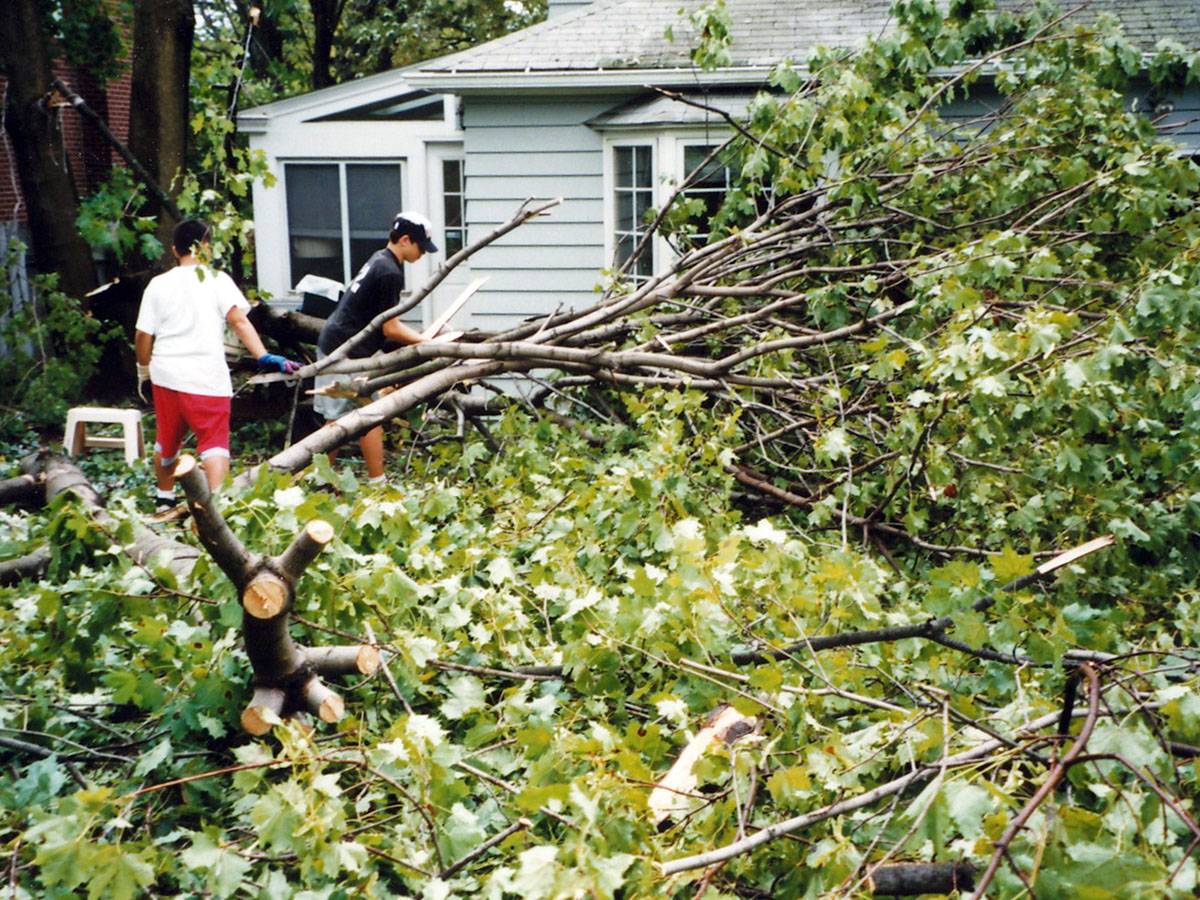The science is clear. Our generations (my own and as well as younger adults) must invent a new style of caring for our piece of the earth.
Some false starts
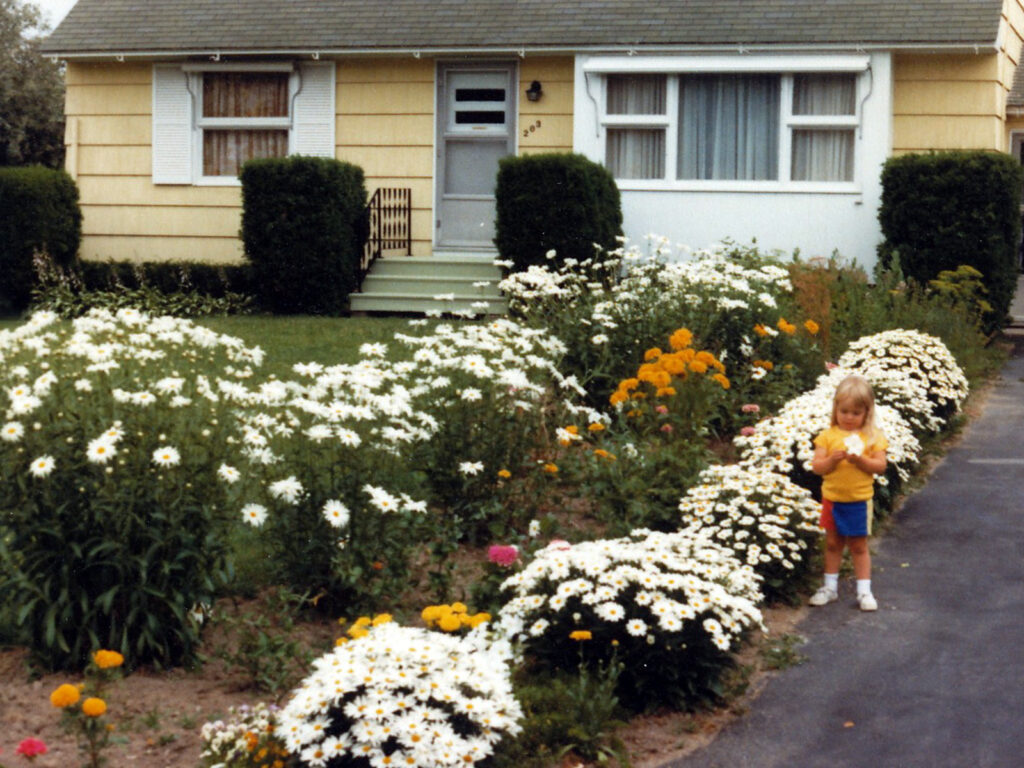
The simplest answer is that we must create living landscapes if we’re to leave our descendants a planet that supports life — not just lots of “pretty” but non-native flowers as we did in our first house.
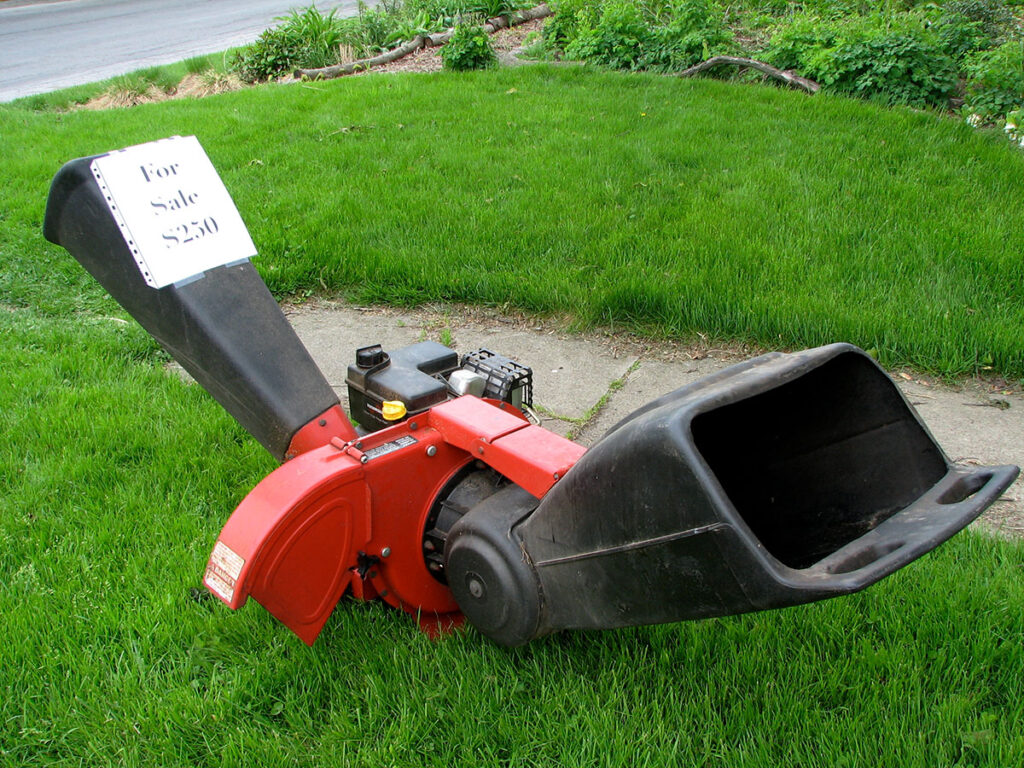
And we now realize that after about twenty years of planting native plants, we also must invent a new way of maintaining this new kind of landscape — a way different from what we learned growing up and as young homeowners. We now leave the leaves, so there’s no need for this leaf shredder.
My evolution as a gardener
From my teen years, I was an ornamental gardener. I wanted the most beautiful, most doubled, most brilliantly-colored flowers I could find. I scoured nursery catalogs for the latest and greatest new creations.
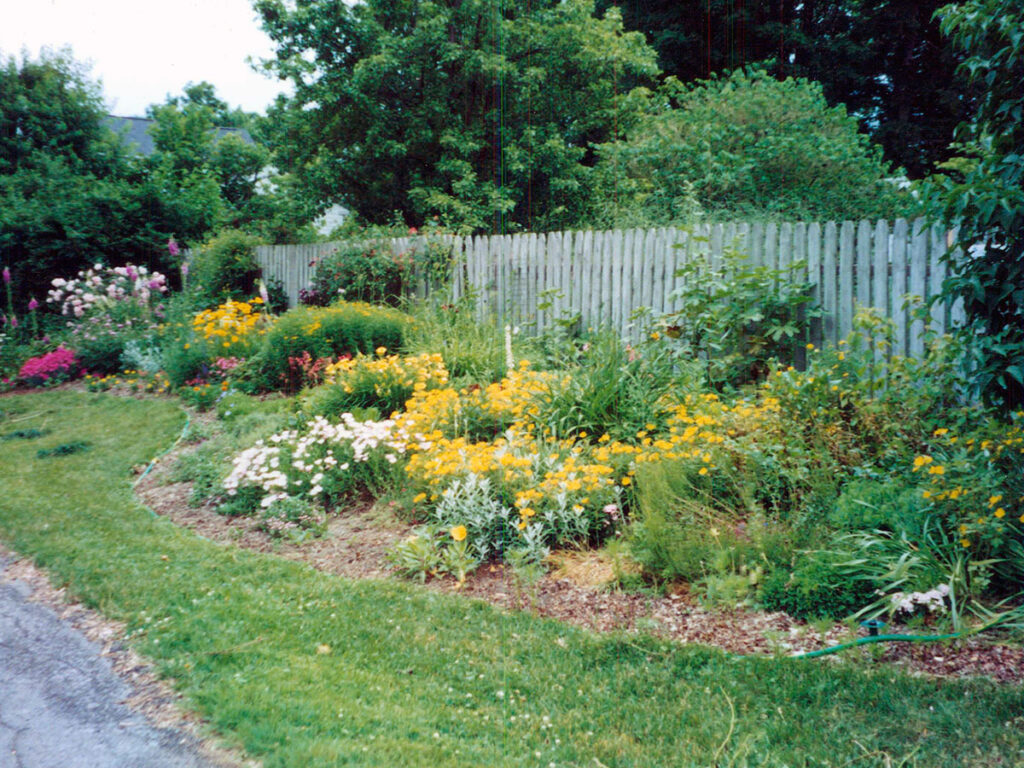
Our home is on a corner lot, so both our side and front yards border a street. Quite a few people in our neighborhood walk for exercise, so during our early years in this house (in the 1980s and 1990s), I planted an increasingly large ornamental flower bed outside our backyard fence for people to enjoy as they walked past.
We changed course
Then on Labor Day 1998, Central New York was hit by a derecho (a straight-line windstorm and thunderstorm similar to a tornado), and our neighborhood was one of its targets.
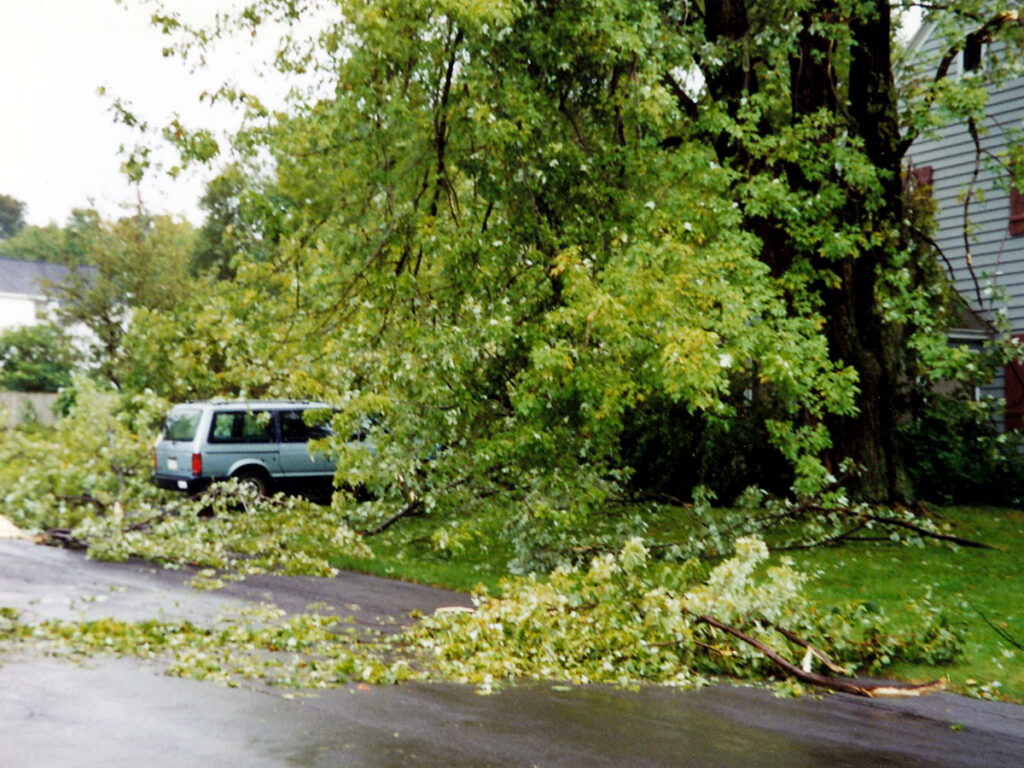
Many large trees were uprooted, some falling on houses. A huge limb of our silver maple fell on all three of our cars, totaling our newest van. Power lines were down for days. Devastation everywhere. We had never seen the like.
The back yard
This disaster, however, turned into an opportunity to significantly change our yard. (I don’t intend to minimize the storm; it was indeed a tragedy for those who were injured or even killed.)
We learned about habitat
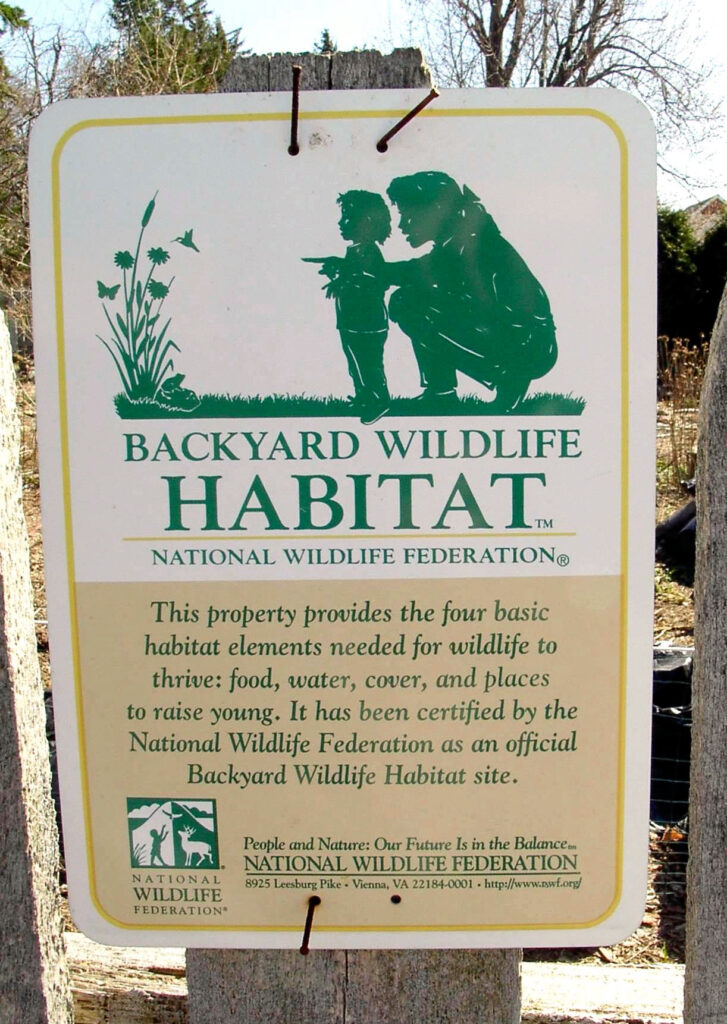
Fortunately I had discovered the National Wildlife Federation’s (NWF) Backyard Wildlife Habitat program (since renamed Certified Wildlife Habitat).
I began to understand that though we might enjoy those ornamental plants now, this kind of landscape might mean no birds and butterflies for our then-future grandchildren to enjoy.
And would there be enough pollinators to produce their food?
Would the earth’s ecosystems that humans depend on function without the biodiversity that was already in decline?
When I was a child back in the 1950s with fewer than 3 billion people on the earth, no one worried about such things. They didn’t need to. There were adequate, though already decreasing, natural areas for wildlife.
Now we’re approaching 8 billion people on the planet. With our sprawling suburbs, bigger houses, larger lots covered with lawn, and more land used for agriculture, there just isn’t enough habitat outside our yards to support wildlife and healthy ecosystems. We realized it’s up to us and our fellow citizens to transform our yards and other public and private spaces into places that support life — now and in the future.
To become a Certified Wildlife Habitat, we had to provide food, water, cover, and places to raise young, as well as using earth-friendly gardening practices. This easy-to-remember mantra gave me something to focus on, although I can’t say I knew what I was doing.
Still, I started adding these elements to my yard as best as I could figure out. Even with some (or many) mistakes, our yard became more creature-friendly and earth-friendly — and, as it turned out, more people-friendly, too!
We discovered native plants
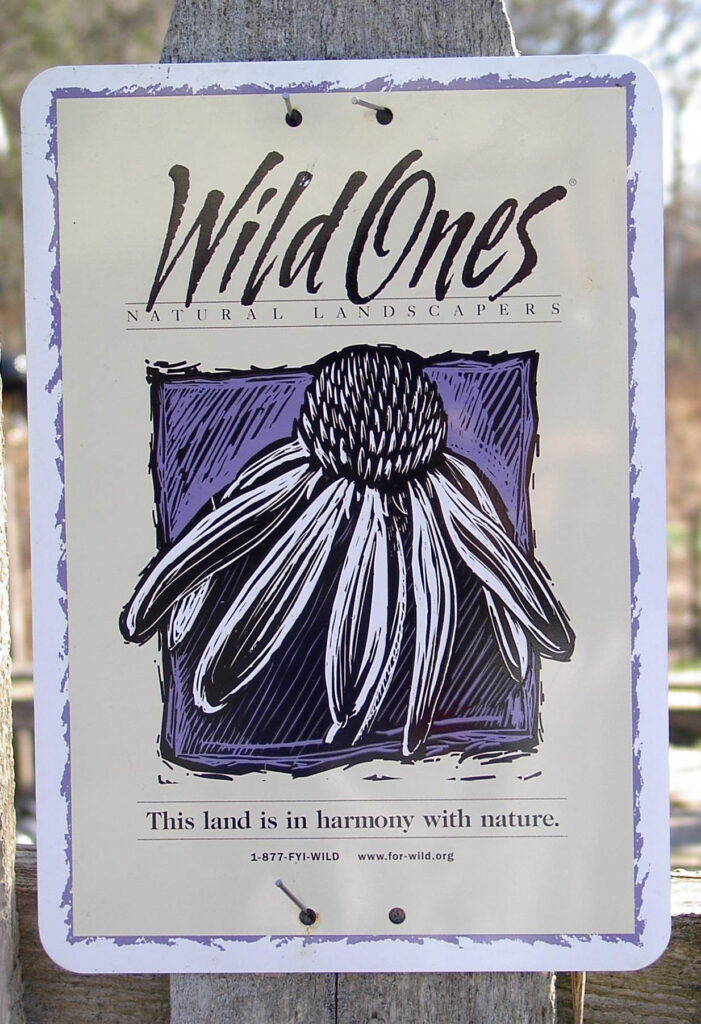
A few years later, we discovered Wild Ones and learned about the importance of native plants and natural landscapes.
No wonder some of those “beautiful” plants I selected from catalogs as being wildlife-friendly weren’t doing their job as advertised!
Some native plant species such as salvia, for example, may theoretically be a good nectar plant, but those “beautiful” hybrid versions offered were bred for what people (like my former ornamental-gardener self) wanted: large, brilliant red flowers. If the plain salvia species provided nectar, then any salvia cultivar or hybrid had the “wildlife-friendly” label slapped on it.
Plant breeders give no thought to whether the plants still had habitat-friendly properties, just whether they would sell. After all, people buy the plants, not wildlife! And most non-native plants aren’t native-wildlife-friendly to begin with.
We discovered monarchs
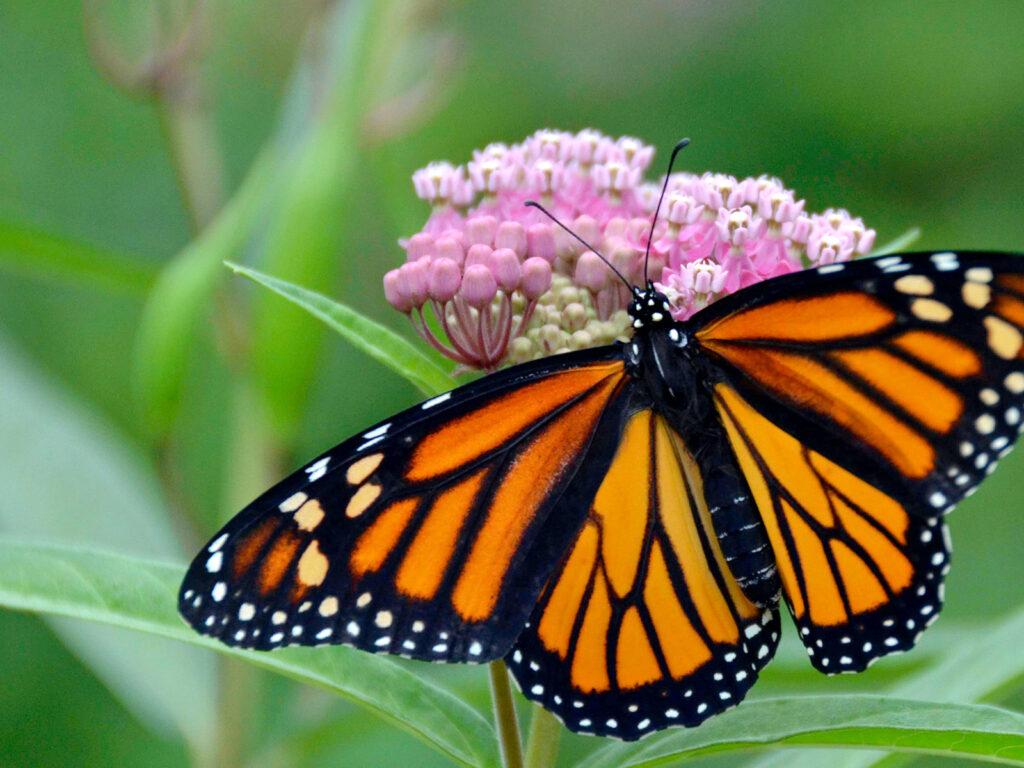
As my yard started to have more birds and butterflies, I noticed a few monarch butterflies drinking nectar. But then I learned that these beautiful butterflies are at risk, in large part due to a declining number of milkweeds, the much-maligned plant essential for monarch caterpillars.
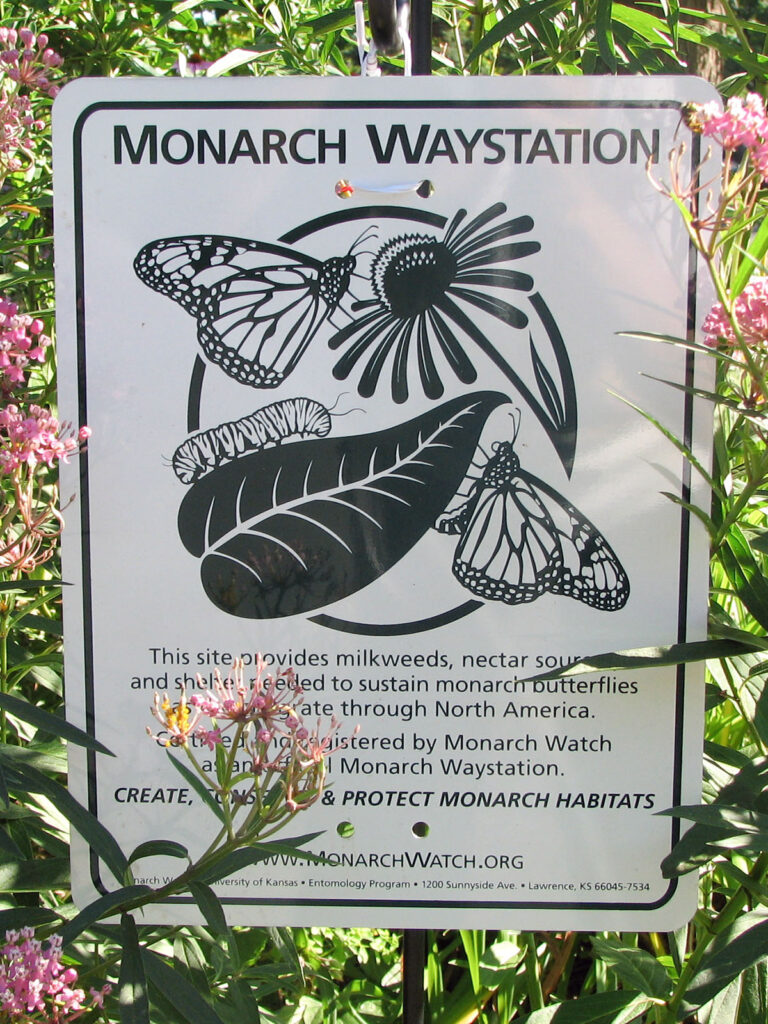
I was thrilled to discovered Monarch Watch, which is working to conserve these butterflies with their Monarch Waystation program.
I started growing more milkweeds for monarchs and eventually more host plants for all kinds of butterflies.
So why a habitat garden?
So that’s something about our evolution as habitat gardeners. We’re still learning, and still making mistakes, but also still adding habitat and becoming more earth-friendly.
A habitat garden is obviously important for the creatures depending on nature to provide what they need to survive — our ethical and moral responsibility — but there’s a greater purpose, too.
By taking care of our own piece of the earth, we’re working to leave a legacy of a living planet to our own grandchildren and to all future generations — human and non-human.
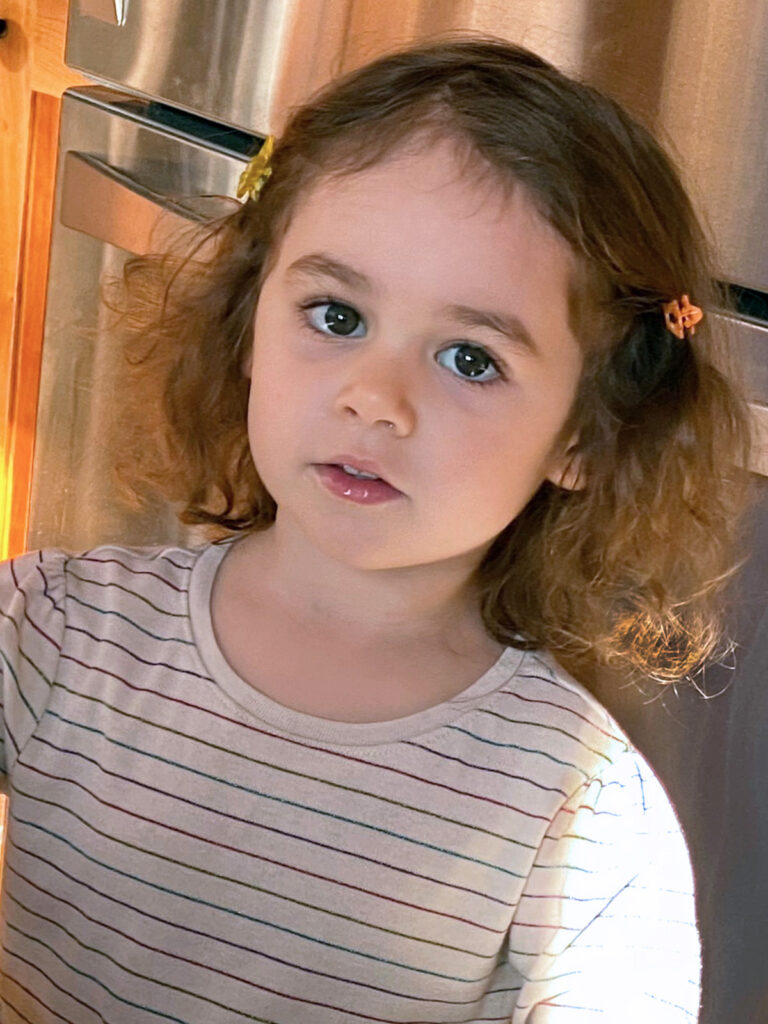
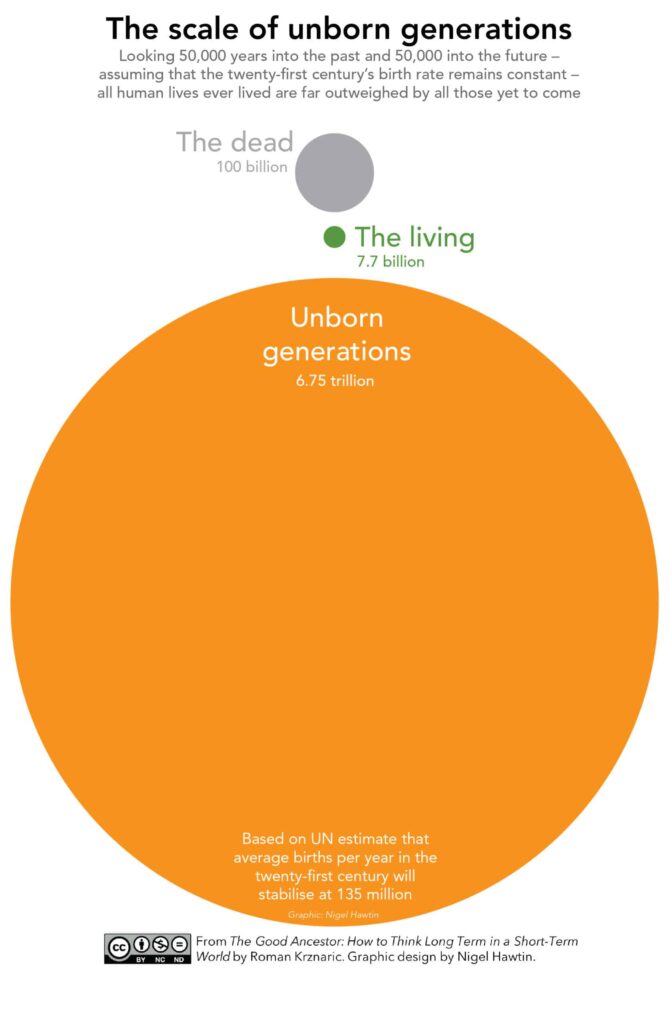
And there are a lot of future humans!
Just as we care about our grandchildren’s futures, so will they care about their grandchildren’s futures and on and on.
As “The Good Ancestor” points out, we — the people currently living (the very small green circle at left) — are a tiny fraction of the people who will come after us and even after our grandchildren.
Are we leaving them a living planet or are we taking everything for ourselves?
Taking good care of our own piece of the earth is one of the many things we must do.
Our goal: Restore and more!
In other words, we want to restore habitat that was here a century ago. But that’s not enough given the many losses since then. We’re trying to use every bit of our land to add even more habitat.
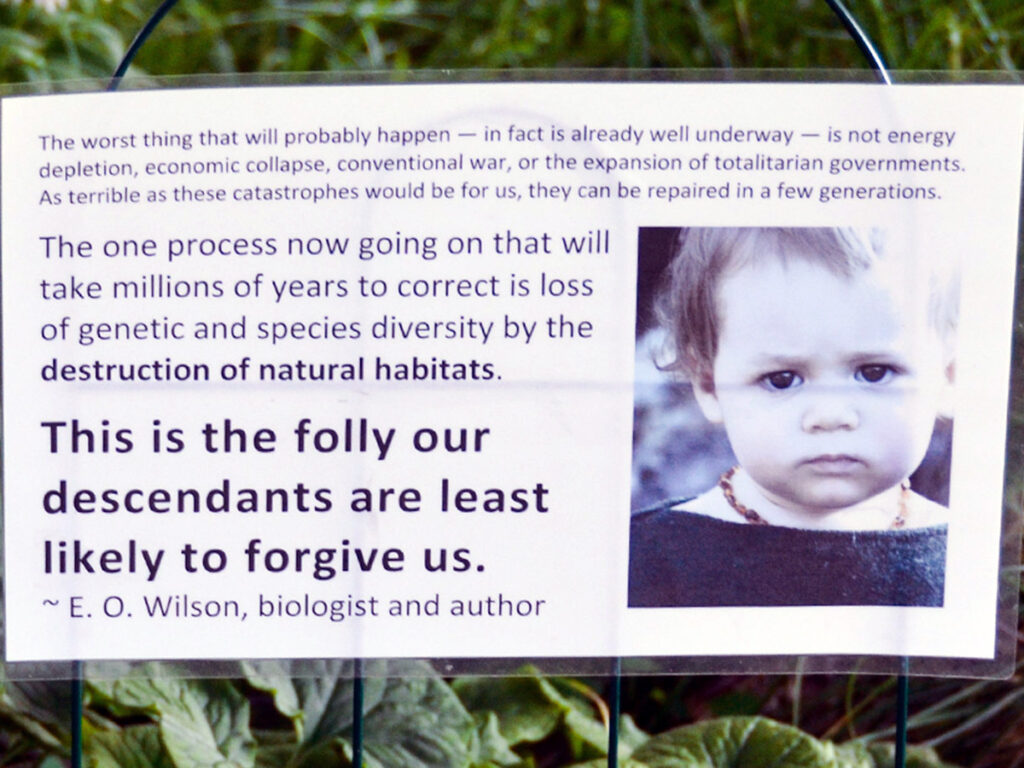
Resources
- Homegrown National Park:
- VIDEO: What’s the rush? – This 24-min video – WHY we must act NOW!
- Living with biodiversity – by Doug Tallamy
- Helping nature take its course
- Ask Doug Tallamy – short videos on a variety of topics
- VIDEO: Time for a new relationship? – short but important 1-min. video
- Wild Seed Project:
- What is rewilding? Not just for natural areas!
- Beyond Pesticides:
- Choose Natives:
- New York Times:
- David Suzuki Foundation:
- CNN:
- Lesley the Bird Nerd:
- Audubon Magazine:
- Sierra Magazine:
- Eco RI News:
- Push to protect pollinators starts at home – Essential for human health and well-being
- Smithsonian Magazine:
- Anthropocene Magazine:
- The residential microsystem – Managed collectively, backyards could become more biodiverse landscapes
- Wilderness Society:
- David Suzuki Foundation:
- Joe Gardener:
- A new garden ethic – interview of Benjamin Vogt, author
- Ecological gardening: Creating beauty and biodiversity
- Grist Magazine:
- NY Flora Association:
- Legacy lost – “Today around only one-half of one percent of original, untouched forest remains in the Northeast.”
- Yale Environment 360:
Seniors taking action!
- Third Act:
- The Third Act organization was founded by climate activist Bill McKibben
- New York Times:
- Gray is Green:
- This organization is for older Americans creating a green legacy – and sign up for their excellent free newsletter
- Roman Krznaric:
- The Good Ancestor – “This is the book our children’s children will thank us for reading.”
- Cornell Univ. College of Human Ecology:
- Aging and climate change clearinghouse – lots of resources
Books
- Douglas Tallamy is author of these highly-recommended books:
- Bringing Nature Home,
- The Living Landscape,
- Nature’s Best Hope, and
- The Nature of Oaks
- Tallamy’s article called “Gardening for Life”, written for the Wild Ones Journal, will give you an overview of the important ideas, but I highly recommend delving into his books!.
- Sara Stein: Another beautifully-written book is Noah’s Garden: Restoring Ecology in Our Own Back Yards – She truly was ahead of her time!
Reflections
It is increasingly clear that much of our wildlife will not be able to survive unless food, shelter, and nest sites can be found in suburban habitats. And because it is we who decide which plants will grow in our gardens, the responsibility for our nation’s biodiversity lies largely with us. Which animals will make it and which will not? We help make this decision every time we plant or remove something from our yards.
~ Doug Tallamy, Bringing Nature Home, 2007
We have a choice. Collective action or collective suicide. It is in our hands.
~ Antonio Guterres, UN Secretary-General
The time for treating our patches of the planet as blank palettes for our creative expressions is over. Now we need to become guardians, not gardeners, to weave the web of life back together, patch by patch. It is time to step up and be part of the solution to the problems that are engulfing our world. To be part of a patchwork quilt of hope.
~ Mary Reynolds, Irish gardener, landscape designer, author, public activist
I see humanity at the mouth of a very, very long dark tunnel. And right at the end of that tunnel is a star. And that’s hope. But it’s no good sitting at the end of the tunnel and hoping that star will come. No, we’ve got to roll up our sleeves, climb over, roll under and work around all the obstacles that lie between us and the star. Like climate change, loss of biodiversity, poverty where people destroy the environment to survive, overconsumption. We’ve got to work on all these things to reach the star. But good news: there’s people working on every single one of them.
~ Dr. Jane Goodall, 2023
We can’t know everything, but we’re learning enough to realize that plundering Earth has consequences. Without plankton or trees or fungi, we wouldn’t have air to breathe. Everything we continue to learn about nature’s intricate balance shows we must recognize our place and care for the planet and its processes as if our lives depended on it. They do.
~ David Suzuki, Everything matters in an interconnected world
“Future people count. There could be a lot of them. And we can make their lives better.” Those sentences form the foundation of an ethical framework known as “longtermism.” They might sound obvious, but to take them seriously is a truly radical endeavor — one with the power to change the world and even your life.
~ Ezra Klein, NYTimes
The ultimate test of a moral society is the kind of world that it leaves to its children.
~ Dietrich Bonhoeffer, German theologian, 1906-1945
At the individual level, we face two significant psychological barriers.
First, we find it difficult to fully grasp the enormity of living at a time when we are destroying the natural systems on which all life (and the global economy) depends. Somehow that reality does not seem real.
Second, we are not able to respond to threats that are remote in time and space.
For example, I might believe that future generations are threatened as certainly as a child on a railroad track in front of a speeding train. For that child, I might risk my life. For future generations, I find it difficult to even forgo comforts.
~ Dick Roy, founder of Northwest Earth Institute (now known as EcoChallenge.org)
In response to the question “What are the primary obstacles to making these changes?” (He was referring specifically to climate change, but the concept applies to changing our lawn-dominated conventional landscaping practices, too.)
The worst thing that will probably happen — in fact is already well underway — is not energy depletion, economic collapse, conventional war, or the expansion of totalitarian governments. As terrible as these catastrophes would be for us, they can be repaired in a few generations. The one process now going on that will take millions of years to correct is loss of genetic and species diversity by the destruction of natural habitats. This is the folly our descendants are least likely to forgive us.
~ E. O. Wilson
We should forever bear in mind that the beautiful world our species inherited took the biosphere 3.8 billion years to build. The intricacy of its species we know only in part, and the way they work together to create a sustainable balance we have only recently begun to grasp. Like it or not, and prepared or not, we are the mind and stewards of the living world.
~ E. O. Wilson, Half-Earth, 2016
The generation that destroys the environment is not the generation that pays the price. That is the problem.
~ Wangari Maathai
Conservation departments, nature preserves, the very law of the land, can’t protect your lot or mine. It’s up to us to do it of our own free will because we understand that the land is not our own but only in our keeping.
~ Sara Stein, Planting Noah’s Garden pp. 16-17
Whether we and our politicians know it or not, Nature is party to all our decisions, and she has more votes, a longer memory, and a sterner sense of justice than we do.
~ Wendell Berry
Unless we modify the places we live, work, and play to meet not only our own needs but the needs of other species as well, nearly all species of wildlife native to the United States will disappear forever. This is not speculation. It is a prediction backed by decades of research on species-area relationships by ecologists who know of what they speak. And the extinction of our plants and animals is not a scenario lost in the distant future. It is playing out across the country and the planet as I write.
Our preserves and national parks are not adequate to prevent the predicted loss of species, and we have run out of the space required to make them big enough. For conservationists, and indeed for anyone who celebrates life on earth, this is perhaps the direst possible consequence of the human enterprise.
~ Doug Tallamy, Bringing Nature Home
The things you do for yourself are gone when you are gone, but the things you do for others remain as your legacy.
~ Kalu Ndukwe Kalu
It is our task in our time and in our generation, to hand down undiminished to those who come after us … the natural wealth and beauty which is ours.
~ John F. Kennedy
The universe is composed of subjects to be communed with, not objects to be exploited. Everything has its own voice. Thunder and lightning and stars and planets, flowers, birds, animals, trees, — all these have voices, and they constitute a community of existence that is profoundly related.
~ Thomas Berry (1914-2009)
Rewilding projects show how quickly nature can bounce back once we set things right and get out of the way. They can also help restore justice, provide hedges against climate disruption, flooding and soil erosion, and offer benefits ranging from recreational to agricultural to economic opportunities. We can’t continue to degrade and destroy the natural systems that our health and lives depend on for the sake of illusory ideals of progress. It’s time to go wild.
~ David Suzuki of The Suzuki Foundation
A true conservationist is a man who knows that the world is not given by his fathers but borrowed from his children.
~ John James Audubon

